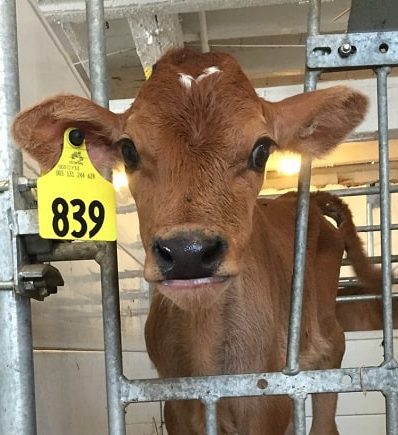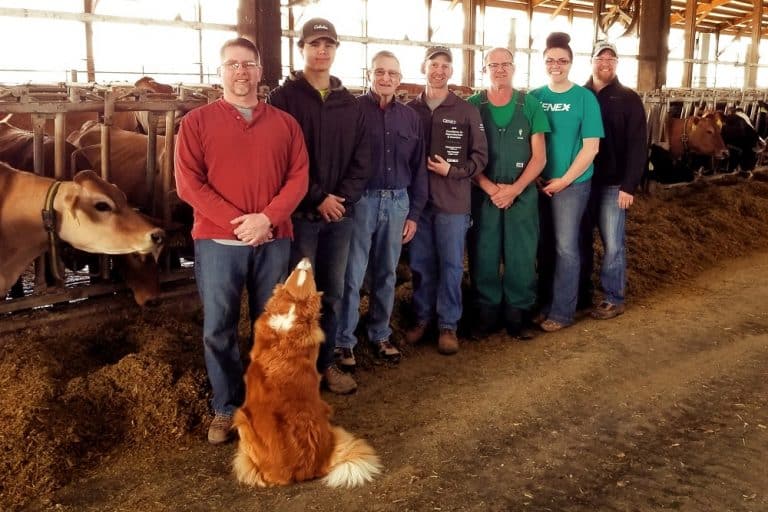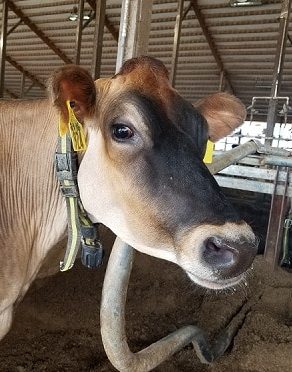Truttmann Dairy, LLC in Blanchardville, Wisconsin, is the Platinum award winner for the less than 500-cow category of the 2020 GENEX Excellence in Genetics & Reproduction awards. Here they share details on the reproduction program that has enabled them to claim that Platinum award two years in a row!
Truttmann Dairy, located in southern Wisconsin, is operated by owners Dan and Shelly Truttmann along with Dan’s father Dwight, brother Doug and nine full‑time employees.
The family began farming in the early 90s, utilizing rotational grazing while focusing on growing cow numbers. In 1998, they built their first barn. By 2012, the herd outgrew the grazing acreage, and the Truttmanns’ turned their focus to cow comfort and production within a freestall facility (though they still utilize some rotational grazing for bred heifers).
Today, the dairy consists of 410 milk cows, mostly Jerseys with a few Holsteins. The herd averages 69 pounds of milk, 4.9% fat and 3.8% protein.
Reproduction
The dairy excels in reproduction with a 37% pregnancy rate, 56% pregnant at first service and 85% bred by 150 days in milk (DIM). The breeding protocol includes an 80 DIM voluntary wait period with cows bred, on average, at 92 DIM.
Cows are bred on a natural heat as much as possible with activity data provided through the Allflex Livestock Intelligence (formerly SCR) Heatime® system. If a cow hasn’t come into heat by 100 DIM, they double lute her and watch for heat. If necessary, the process is repeated 14 days later and in rare instances followed with Ovsynch.

The top 50% of cows receive up to two services of sexed semen. If needed, that is followed by up to two services of conventional beef semen. It equates to 40% sexed semen use with a 48% sexed semen conception rate for Jersey GenChoice™ sexed semen.
In 2019, the dairy started using male-sexed beef semen. Therefore, the bottom 50% of the herd receives up to two services of sexed male semen, followed by two services of conventional beef semen, as needed.
Teamwork
“It has taken a team to get where we are repro-wise and to keep it consistent to win the Platinum award two years in a row,” explains Lindsey Geddes, GENEX Reproductive Program Senior Technician who provides the breeding service.
“From the healthy happy cows to the owners, employees, nutritionist John Binversie with Quality Liquid Feeds, veterinarian Tim Bruns, and the GENEX team, including reproductive consultant Adam Koppes, sales manager Scott Schultz, it’s a team effort.”

Dan says he enjoys working with GENEX because of the bull lineup (particularly the positive DPR Jersey sires) and because he can trust GENEX representatives to have the dairy’s best interest at heart.
“Lindsey and Scott take great care of us and our herd,” notes Dan. “Lindsey is the best! Her personality is bigger than even the Jerseys, and she does an amazing job of knowing the herd and not missing a thing. I never have to think about whether the job is done right. It always is.”
Tools
Four years ago, the dairy’s reproduction program changed after Dan put in the Heatime® system with activity and rumination monitoring collars. He wanted the system specifically for health monitoring for the pre- and post-fresh cows and wasn’t certain it would do a better job at heat detection than tail chalk.
“However, after two weeks, we let the collars do the work and our conception rate improved soon after!” notes Dan. “Our preg rate went up by 10 points, all while cutting hormone use to near zero and significantly increasing the use of sexed semen.”
Dan adds, “We don’t miss heats like before. The system is great at detecting estrus and showing how strong a heat is. It has forced us to wait a bit longer before breeding, knowing the optimal time to breed. In addition to helping improve reproductive performance, it has helped keep the herd healthy and minimize lameness too.”


